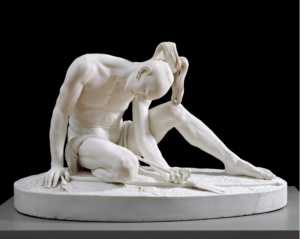The sculpture The Wounded Indian has been a point of contention between two American organizations for several decades. But finally, everyone can put the matter to rest. The Boston artist Peter Stephenson created the sculpture, making it the first life-size sculpture completely made from American marble. It was completed in 1850, entirely sculpted from a single piece of white Vermont marble. It is part of a nineteenth-century American artistic tradition that constructs idealized, almost mythologized, versions of indigenous people, ranging from the noble savage to the barbarous raider on horseback. It is unlikely that Stephenson ever came into contact with indigenous people since, by his lifetime, most were killed by disease or conflict with settlers, or they had been displaced and forced across the Mississippi River. Rather than basing the sculpture on any indigenous person, Stephenson based The Wounded Indian on a sculpture popularly known as The Dying Gaul, an ancient Roman copy of an earlier Hellenistic Greek statue. The Dying Gaul consists of a naked Gallic warrior with a wound on his right side collapsed on the ground next to his sword. This ancient statue is part of the Capitoline Museum’s collection in Rome.
After its creation, Stephenson exhibited The Wounded Indian at London’s Crystal Palace for the Great Exhibition of 1851. Since 1986, it has been in the Chrysler Museum of Art collection in Norfolk, Virginia. Walter P. Chrysler Jr., who founded the museum with his collection, acquired it from the New York collector James Ricau, despite no documentation about how it came into Ricau’s possession. Before Ricau, the Massachusetts Charitable Mechanic Association (MCMA), a philanthropic organization in Boston that promotes the mechanical arts and provides technical training, was the last known owner, having acquired it in 1893. The Wounded Indian was lost when the MCMA vacated its Boston premises in 1958. According to the MCMA, the sculpture was believed to have been damaged or destroyed during “the chaos of moving”. It is unknown who salvaged the statue or who it belonged to before Ricau purchased it.
The MCMA discovered the sculpture in the Chrysler collection in 1999, and since then, the Boston charity has asked that the Chrysler return the Stephenson work to them. At first, the Chrysler Museum administration resisted, claiming that the work previously owned by the MCMA must have just been a copy, while they have the original. The two organizations later negotiated for the Chrysler to loan The Wounded Indian to the MCMA. However, talks broke down when the MCMA demanded the Chrysler recognize their previous ownership of the sculpture and pay $200,000 to cover what it had already spent trying to regain ownership. But now, after over twenty years, the Chrysler Museum director Erik Neil agreed to return The Wounded Indian to the MCMA, recognizing their previous ownership but with no payment necessary. Neil called the arrangement “amicable”. The MCMA plans to stage an exhibition focusing on the sculpture but is searching for a place to put it on permanent display, lacking any galleries.

